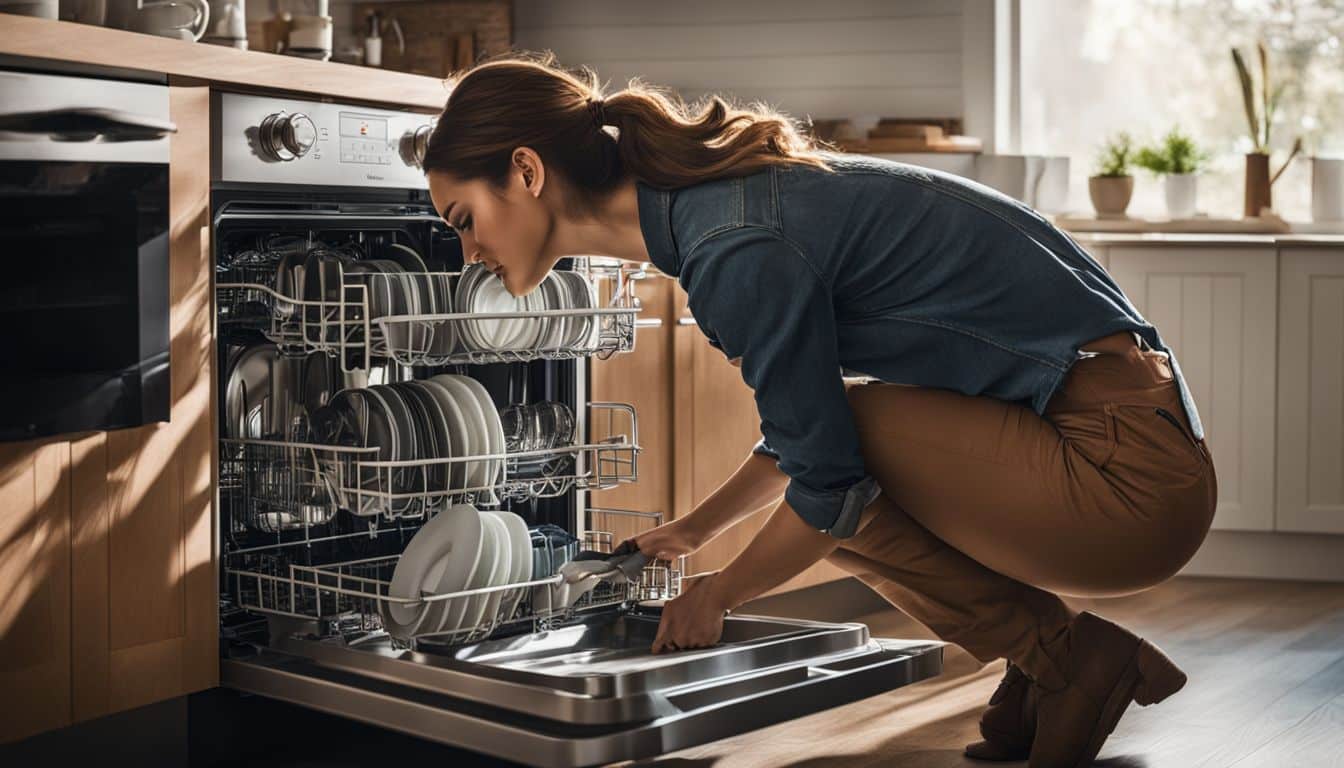Keeping a home sparkling clean is no small feat, especially when it comes to those major appliances that work hard behind the scenes. From sticky refrigerators packed with last week’s leftovers to dusty washing machines hiding forgotten socks, these essential devices often get overlooked in the hustle and bustle of daily chores.
The problem many face isn’t just finding the time to clean, but knowing how to do it effectively without causing damage or wasting hours. This is an essential part of a proper house cleaning.
Here’s an interesting fact: research shows that regularly cleaning your appliances can not only extend their lifespan but also improve their efficiency, saving you money on energy bills in the long run.
This guide aims to arm house owners and parents with simple yet powerful strategies for tackling everything from grimy microwaves to soiled ovens. You’ll discover tips on using household items like vinegar and baking soda to achieve a deep clean without harsh chemicals.
Get ready for cleaner, happier appliances!
How to Clean Different Types of Major Appliances

To clean a refrigerator, remove all items from inside, and wipe down the shelves and walls with a solution of mild detergent and water. For the dishwasher, remove debris from the filter area, wipe down the interior with vinegar to eliminate odors, and scrub around the door seal to prevent mold growth.
Refrigerator

Keeping your refrigerator clean not only prevents the growth of bacteria but also ensures it runs efficiently. Start by emptying all contents and removing shelves and drawers. Wash these parts with a mixture of warm water and dish soap.
Wipe the interior with a solution of water and baking soda to eliminate odors, paying extra attention to any spills or stains. This simple yet effective cleaning method helps in maintaining your appliance’s performance while safeguarding your family’s health.
For the exterior, use a damp cloth dipped in soapy water for enameled surfaces, or opt for a specific cleaner if you have stainless steel appliances. Don’t forget to pull the unit away from the wall to vacuum dust off the coils at least twice a year; this step is crucial for maintaining efficiency and extending the life of your refrigerator.
Always ensure that food is properly sealed before returning it to prevent future odors and contamination, keeping your kitchen safe and hygienic for family meals and spring cleaning rituals.
Dishwasher

When it comes to the dishwasher, cleaning both the interior and exterior is crucial for optimal performance. Remove and clean the filter regularly using warm soapy water and a soft brush to remove any food particles or debris that may have accumulated.
Wipe down the door gasket with a damp cloth to ensure a tight seal, preventing leaks during cycles. Additionally, run an empty cycle with a cup of white vinegar in a dishwasher-safe container placed on the top rack to eliminate any lingering odors and disinfect internal components.
To maintain cleanliness, wipe down the exterior with a solution of mild dish soap and water, avoiding abrasive cleaners that could damage the finish. Pay special attention to controls, handles, and buttons as they tend to accumulate grease and grime over time.
Microwave

Now, let’s move on to the microwave. To clean the inside, place a bowl of water with lemon slices in the microwave and heat it for 3-5 minutes. This will help loosen any splattered food, making it easier to wipe clean.
Then, remove the turntable and wash it in warm soapy water or in the dishwasher if it’s dishwasher-safe. Wipe down the interior and exterior of the microwave with a gentle cleaner or a mixture of vinegar and water using a microfiber cloth.
For stubborn stains or odors, make a paste using baking soda and water, apply it to problem areas, then scrub gently with a sponge before wiping away with a damp cloth. It’s important to always unplug your microwave when cleaning for safety reasons.
Stove and Oven

To deep clean the stove and oven, start by removing the grates and burner caps. Soak them in warm, soapy water for 15-20 minutes. Use a non-abrasive sponge or cloth to wipe down the stove’s surface with a mixture of baking soda and water.
For tough stains on the stovetop, use a paste made from baking soda and vinegar. Clean the oven by wiping it down with a damp cloth after using an oven-safe cleaning solution.
Once both are clean, return the burners to their places and run an empty cycle in your oven at high heat to remove any lingering smells. Regularly doing this will ensure that these appliances remain spick and span.
Stainless Steel Appliances

Moving on from cleaning the stove and oven, maintaining stainless steel appliances is also crucial in keeping your kitchen looking sleek and stylish. Wipe down your stainless steel appliances with water and a mild detergent, then dry them with a soft cloth to prevent water spots.
For tougher stains or fingerprints, use a mixture of water and vinegar for an effective natural cleaner. To maintain their shine, apply a small amount of mineral oil to the surface and buff it out using a clean cloth in circular motions.
Maintaining the beauty of stainless steel appliances enhances the overall look of your kitchen while keeping them free from smudges and marks. Regular upkeep ensures that they stay looking new for longer periods without needing costly replacements.
Washing Machine and Dryer

To keep the washing machine and dryer in top condition, wipe down the exterior with a damp cloth and mild detergent. Ensure to clean the lint filter after every use to prevent buildup.
Clean the inside of the washing machine by running a cycle with hot water and vinegar or baking soda. For the dryer, vacuum out accumulated lint from the vent and drum regularly.
Regular maintenance of these appliances is essential to ensure they function effectively for longer periods. House owners & parents should prioritize cleaning their washing machine and dryer as part of their household cleaning routine.
Tips and Tricks for Effective Appliance Cleaning

To clean major appliances effectively, mix vinegar and water to create a natural cleaning solution. Baking soda can also be used for degreasing and removing tough stains from different types of appliances.
Using vinegar and water mixtures
Mixing equal parts of vinegar and water creates a powerful cleaning solution. This mixture effectively removes grease, grime, and mineral deposits from various kitchen appliances. The acidic nature of vinegar helps to break down tough stains while the water dilutes its strength, making it safe for use on most surfaces.
Using baking soda for degreasing

Baking soda effectively removes tough grease and grime from kitchen appliances. Sprinkle baking soda on a damp cloth and scrub the greasy areas, then wipe clean with a wet cloth for shiny results.
Baking soda’s mild abrasive properties make it an excellent natural degreaser for stovetops, ovens, range hoods, and other greasy surfaces.
Its powerful deodorizing qualities also help eliminate lingering odors in the process. For particularly stubborn grease buildup, make a paste of baking soda and water to create a thicker scrubbing solution that can tackle even the most challenging spots on your appliances.
Including small appliances in your cleaning checklist

Don’t forget to add small appliances like coffee makers, toasters, and blenders to your cleaning checklist. Wipe down the exteriors with a damp cloth and mild detergent. For difficult spots, use a paste of baking soda and water to scrub away grime.
Run a cycle with vinegar and water through your coffee maker for deep cleaning. Make sure to unplug all appliances before cleaning them.
Regularly wiping down small appliances will keep them looking good while preventing buildup that can affect performance. Neglecting cleaning these items might lead to the growth of bacteria or mold in areas where food particles accumulate.
Regular maintenance and maintenance tips

To keep appliances running smoothly, perform regular maintenance. Wipe down the exterior of appliances with a mild detergent and water to remove any spills or stains. Check seals and gaskets on refrigerators and dishwashers for signs of wear and tear, replacing them if necessary.
Clean filters in washing machines, dryers, stoves, ovens, and microwaves as recommended by the manufacturer to prevent blockages.
For stainless steel appliances, use a soft cloth with mild soap and water to clean surfaces regularly. Use vinegar or baking soda for stubborn stains but avoid abrasive cleaners that can scratch the surface.
Also, remember to inspect power cords and plugs for any damage or fraying that could pose a safety hazard.
Conclusion

Make appliance cleaning a breeze with these effective tips and tricks. Remember to regularly maintain your appliances for optimal performance. Keep those major appliances sparkling clean with simple natural solutions.
Show some love to your kitchen by maintaining and deep-cleaning its major appliances.






